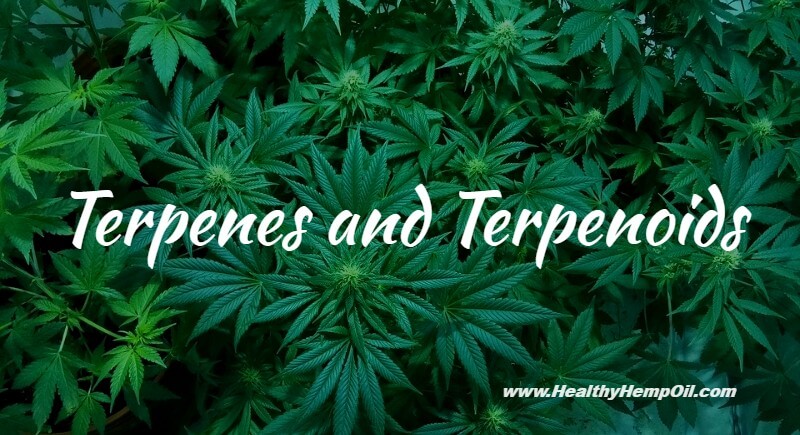Education
Terpenes and Terpenoids
The Difference Between Terpenes and Terpenoids
According to Chem Wiki, backed by the University of California Davis, terpenes and terpenoids can be argued to comprise the largest and most diverse class of natural products with many being found in plants. Some more complex terpenes can even be found in animals. But what characteristically defines a terpene?
Terpenes may be considered to be made up of isoprene (more accurately, isopentane) units, an empirical feature known as the isoprene rule. Because of this, terpenes usually have 5n carbon atoms (n is an integer) and are subdivided into monoterpenes (2 isoprene units), sesquiterpenes (3 isoprene units), diterpenes (4 isoprene units), sesterterpenes (5 isoprene units), and triterpenes (6 isoprene units).
All this tells us the chemical structure of terpenes. An isoprene unit can be thought of literally as the carbon skeleton on the atomic level. Many chemical compounds have carbon skeletons since, at the atomic level, carbon is capable of making four bonds (unlike many other elements). This gives it the unique ability to act as a backbone for compounds, and it is the reason that we on Earth are called “carbon-based lifeforms.”
Isoprene itself is known as C5H8 (5 carbons and 8 hydrogens), making it a gaseous hydrocarbon. So, to give you an idea about what differentiates the other terpene subgroups, it’s just a matter of atomic quantity. Monoterpene is doubled in atomic quantity compared to isoprene; it can be expressed as C10H16. Meanwhile, isoprene is only C5H8. Additionally, isoprene is emitted by the leaves of various plants as a byproduct of plant metabolism. This might help you to get a grasp on just how vast and all-encompassing terpenes truly are.
The term “terpene” is often used interchangeably with “terpenoid.” But, according to Medical Jane, “Terpenes are referred to as terpenoids when denatured by oxidation (drying and curing the flowers).” To put it simply, terpenoids are often just “modified terpenes.” That doesn’t mean that they’re genetically modified; they’re just oxidized versions of terpenes. And terpenes aren’t limited to just the cannabis plant.
Function of Terpenoids and Terpenes in Plants
According to the book Vitamins and Hormones from the Institute of Vegetable Science, terpenoids have a wide array of function as antioxidants and other agents.
Terepenes are essentially the oils that give plants (including cannabis plants) their specific smell. They interact with our endocannabinoid system much like cannabinoids and can even influence neurotransmitters like dopamine and serotonin, slowing or increasing production depending on the specific terpene. This is the reason why terpenes affect your mood or sensation when you smoke cannabis.
For example: Limonene, a common terpene found in the cannabis plant, causes marijuana strains to smell citrusy, but it also increases seratonin production, thus increasing feel-good sensations.
Action in the Cannabis Plant
But what about the cannabis plant? Over 200 terpenoids have been identified in Cannabis Sativa. They make up less than 1% of the chemicals present in reports on the cannabis plant, but they might make up about 10% of the trichome content. (In case you’re not familiar with trichomes, a trichome is defined as “a small hair or other outgrowth from the epidermis of a plant, typically unicellular and glandular.”) Ten percent might seem small, but it represents a large influence.
According to an article in the British Journal of Pharmacology, terpenoids increase with exposure to light but decrease with soil fertility, as is also observed in cannabinoids. They also have an array of applications. They are lipophilic and interact with cell membranes, neuronal and muscle ion channels, neurotransmitter receptors, G-protein coupled receptors, second messenger systems, and enzymes.
Myrcene and B-Caryophyllene
A frequently predominate terpene found in cannabis extracts is B-Caryophyllene, a sesquiterpene. It can act as an anti-inflammatory agent via the PGE-1 pathway and is also a selective full-on agonist at CB2. For the record, this is the only terpene known to be a full-on CB2 agonist. There is generally no attribution of psychoactivity with CB2 agonists, and B-Caryophyllene does not produce psychotropic effects.
Myrcene takes the award for being the most common terpene found in cannabis. Its profile on Medical Jane tells us that it has the ability to make the blood-brain barrier more penetrable. This allows itself and many other chemicals to affect the brain more easily. For this reason, it can attenuate the speed with which chemicals like THC might have an effect. Myrcene itself is not psychotropic and can be found in the oil of hops, mangoes, bay leaves, eucalyptus, wild thyme, and lemongrass.
In one study published in the Journal of Ethnopharmacology, Myrcene was found to be the root of lemongrass’s analgesic effects. But B-Caryophyllene and myrcene are both examples of terpenes that can cause an “entourage effect” with phytocannabinoids present in plant extracts. It is also important to note that, according to a bioassay of hemp seed oil in“The Composition of Hemp Seed Oil and Its Potential as an Important Source of Nutrition, myrcene and B-Caryophyllene are present abundantly:
The presence of several terpenes were confirmed in the seed oil, the most abundant of which were -caryophyllene and myrcene which were found at 740 mg/L and 160 mg/L, respectively. The terpene compounds, in general, are primarily found in the essential oil of Cannabis rather than in the seed oil (Hendriks et al., 1978) as a result of their production in the glandular structures on the aerial portions of the plant. These compounds are a component of the characteristic aroma of Cannabis and may impart some of these properties to the seed oil. (Leizer et al. 49) Additional benefits may be provided to the oil as well.
By contrast, whole cannabis extracts or marijuana strains include a much more diverse list of terpenes and terpenoids in higher doses and concentrations, depending on the strain.
Aromatic Properties of Terpenes
Not only do terpenes have their own benefit and application, but they often have an aroma as well. In fact, the scent of your different strains of cannabis is primarily due to the terpenes and terpenoids present.
Zamnesia, an online headshop, elucidates the aromas of the following terpenes:
Borneol
- Aroma: Spicy, menthol, camphor
- Effects: Sedative, calming
- Also found in: Cinnamon, galanga, and wormwood
- Strains high in Borneol: The church, Diamond Girl, Green-o-matic
Carene
- Aroma: Sweet, cedar, pungent
- Effects: Unknown
- Also found in: Cedar, pine, rosemary
- Strains high in Carene: El Niño, Lemon Skunk, King’s Kush
Caryophyllene
- Aroma: Spicy, warm, sweet, woody
- Effects: Unknown
- Also found in: Black pepper, hops, lavender, rosemary, cloves, oregano.
- Strains high in Caryophyllene: Arjans Haze #2, Super Silver Haze, Nevilles Haze
Eucalyptol
- Aroma: Spicy, minty, camphor
- Effects: Centering, balancing and stimulating
- Strains high in Eucalyptol: Kings Kush, ChemDawg, Bubba Kush
Limonene
- Aroma: Sour, citrus (lemon, orange, grapefruit)
- Effects: Uplifting, refreshing
- Also found in: Citrus fruits, rosemary, peppermint
- Strains high in limonene: OG Kush, Damn Sour, Diamond Girl, Super Lemon Haze, Jack the Ripper, Lemon Skunk
Linalool
- Aroma: Sweet, flowery, citrus, candy like
- Effects: Uplifting and sedating
- Also found in: Over 200 plants: Lavender, mints, rosewood, citrus fruits, birch trees, and even some fungi
- Strains high in linalool: Amnesia Haze, Grape Ape, G-13, Lavender, Deep Purple, LA Confidential
Myrcene
- Aroma: Sweet, fruity, green vegetative, tropical, earthy
- Effects: Sedation and relaxation
- Myrcene is also found in: Mango, hops, lemongrass, thyme, guava, East Indian bay tree, verbena and mercia
- Strains high in myrcene: White Rhino, Sweet Mango Auto, K. Train, El Niño, Skunk #1, White Widow
Pinene
- Aroma: Pine
- Effects: Mental Focus, alertness, aids memory, counteracts some of the effects of THC
- Also found in: Pine needles, rosemary, basil, parsley, dill
- Strains high in pinene: Trainwreck, Cheese, ChemDawg, Super Critical, Jack Herer, Bubba Kush, Super Silver Haze
Terpineol
- Aroma: Sweet, floral, citrus, lilac
- Effects: Strongly physically relaxing, responsible for the couchlock
- Also found in: Apple blossoms, orange
- Strains high in Terpineol: Money Maker, White Rhino, Superbud
In Conclusion
As always, we hope this article has been informative about the other chemical compounds known to the cannabis plant beyond the phytocannabinoids. To sum up:
- terpenes are a huge class of compounds found in many different plants and, in a few scenarios, animals;
- Terpenoids are oxidized terpenes;
- Terpenes make up a small amount of cannabis profiles but still can have profound effects;
- Terpenes can induce “the entourage effect”;
- Terpenes are mainly responsible for the cannabis aroma;
- At least one terpene is known to be a full-on CB2 receptor agonist;
- Myrcene makes the blood-brain barrier less resistant; and
- Hemp seed oil has most myrcene and B-Caryophyllene.
As a reminder, our high-CBD products come from safe industrial hemp. To learn more about these our CBD supplements, visit our product page. And tell us, have you perhaps used and derived benefit from any natural products that might have included a terpene mentioned above? Let us know in the comments. And don’t hesitate with any questions.
FDA Disclaimer: These statements have not been evaluated by the Food and Drug Administration. Products sold by Healthy Hemp Oil are not intended to diagnose, treat, cure, or prevent any disease. The information on our website is intended to provide general information regarding our products and is not to be construed as medical advice or instruction. Read more


Comments are closed.